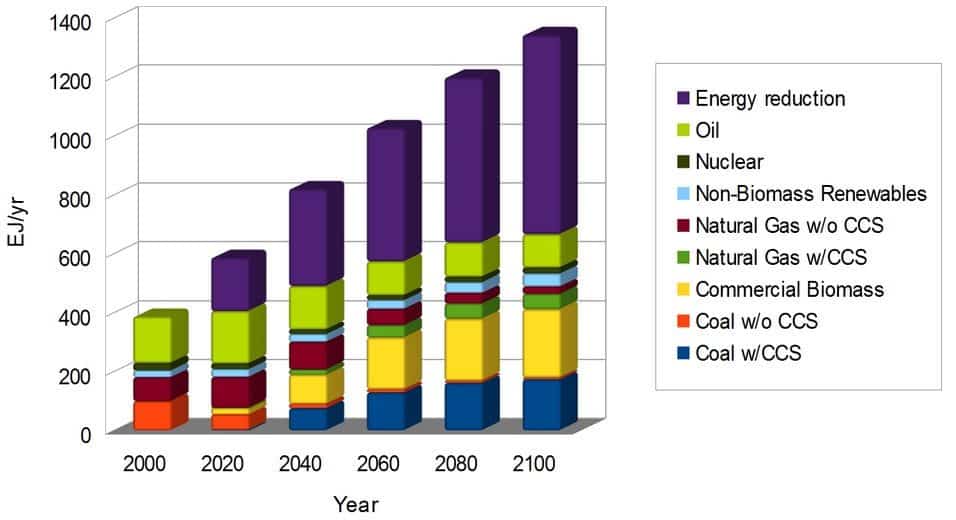
Although GCMs provide the most detailed simulations of future climate change, computational constraints preclude their use in sensitivity studies that allow one to investigate the potential effects of real-world future greenhouse gas emissions. By using simpler climate models, it is possible to estimate future changes in the global-mean surface air temperature induced by different scenarios of radiative forcing. A number of these scientific scenarios have been identified by the IPCC (1990a, 1992). The radiative forcing scenarios themselves are determined by policy scenarios which estimate the time evolution of greenhouse gas concentrations in response to various emission scenarios. Figure 6.15 illustrates the sequence of modelling studies that has been undertaken by the IPCC.
For the 1990 IPCC Scientific Assessment, four future greenhouse gas emission scenarios were developed and used to produce estimates of the resulting rate and magnitude of climate change, represented by the global average surface temperature, up to 2100. These were updated to six emissions-climate response scenarios in the 1992 report. Calculations for the 1992 report were performed using a 1-D climate model and a series of gas cycle models that relate emissions to concentration changes (STUGE, Wigley et al., 1991). Climate feedbacks were not explicitly modelled but their effects are accounted for by varying the value of the climate sensitivity, as determined by GCMs.
The assumptions used to formulate the IPCC 1992 emissions scenarios (IS92a to f) may be found in IPCC (1992 & 1995), whilst Figure 6.16 shows the time evolution of CO2 emissions, the main greenhouse gas, for each scenario. IS92a and IS92b are revised versions of the IPCC 1990 “business-as-usual” scenario (SA90) which assumed no climate-interventionist policy during the next century. IS92c and IS92d provide example of possible “best-case” scenarios” whilst IS92e and IS92f represent possible “worst-case” scenarios. Similar time evolutions exist for the other greenhouse gases. Figure 6.17 illustrates the greenhouse radiative forcing associated with each of the emission scenarios, calculated from the estimated increase in greenhouse gas concentrations. Figure 6.18 then shows the global-mean temperature change estimates for each case, assuming the “best-guess” value for the climate sensitivity (2.5C) as modelled by GCMs. The simulated temperature increases across the range climate sensitivities are shown for the IS92a scenario in Figure 6.19.
Using the “best-estimate” sensitivity, these scenarios give a range of warming from 1.5 to 3.5C by the year 2100 (Figure 6.18). Under “business as usual” conditions, global-mean surface temperature is expected to rise by between 2 and 4C over the next hundred years, depending on the climate sensitivity (Figure 6.19). Clearly, even the most optimistic projections of greenhouse gas accumulation seem unable to prevent a significant change in global climate during the next century. Under a “worst-case” scenario with a high climate sensitivity, global-mean surface temperature could rise by 6C by 2100. Significantly, however, these projections are based solely on changes in greenhouse gases; no account has been taken of the negative forcing influence of stratospheric ozone loss or sulphate aerosols.
Using “business-as-usual” projections of greenhouse gas emissions and sulphate aerosols, the Hadley Centre used a transient GCM to simulate the climatic effects of both positive greenhouse forcing and negative aerosol and stratospheric ozone forcing (Hadley Centre, 1995). As well as replicating the twentieth century global temperature increase (section 6.8), the model also refined future projections of climate change. Figure 6.20 illustrates the modelled past and future global-mean temperature changes, from 1860 to 2050. The negative forcing of sulphate aerosols, despite its regionality, unarguably reduces the projected temperature increase beyond the present. Under “business-as-usual” conditions, and with a “best-estimate” climate sensitivity, the global-mean surface temperature is projected to rise by approximately 0.2C per decade. This can be compared to the IPCC (1992) prediction of a 0.3C rise per decade.




Leave a Reply